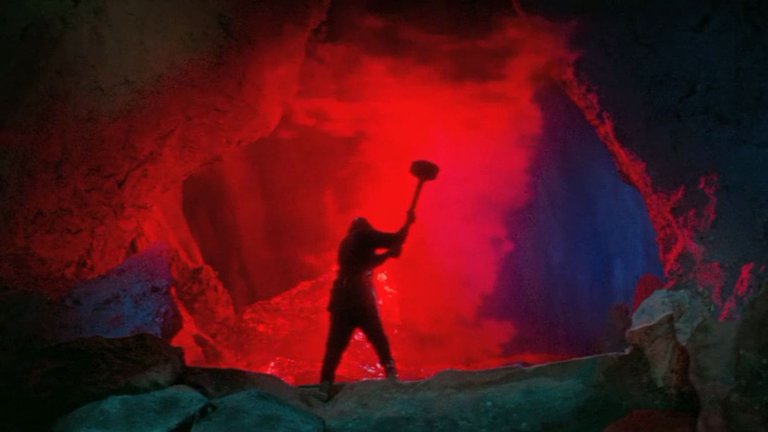
Soviet cinema, despite often being constrained by an oppressive regime, occasionally produced films that, on the surface, appeared free from overt political and ideological messages. These works could be appreciated by audiences who had little affinity for the Soviet government, allowing them to transcend cultural and political barriers, particularly during the Cold War. However, in the case of Sampo, the 1959 fantasy epic directed by Aleksandr Ptushko, this cross-cultural transfer did more harm than good for the film's overall reputation.
The film is based on the Kalevala, a compilation of Karelian folk poems meticulously gathered by Elias Lönnrot in the 19th century. This collection is not only regarded as the national epic of Finland but also served as a significant source of inspiration for renowned authors such as J.R.R. Tolkien.
Sampo begins in the ancient land of Kalevala, where the young adventurer Lemminkäinen, portrayed by Andris Ošiņš, is set to marry the beautiful maiden Annikki, played by Eve Kivi. However, their joyous plans are thwarted when Annikki is abducted by Luohi (played by Anna Orochko), the malevolent witch queen of the distant northern land of Pohjola. Luohi seeks to compel Annikki’s brother, the famed blacksmith Ilmarinen, played by Ivan Voronov, to forge the Sampo—a magical mill that produces endless riches. To rescue Annikki, Lemminkäinen and Ilmarinen embark on a perilous journey to Pohjola, where they must complete a series of daunting tasks set by Luohi to secure her release.
The production of Sampo was a co-operative effort between the Soviet Union and Finland, a move that could be interpreted as an attempt by the Soviet regime to demonstrate goodwill towards its neighbour by paying homage to its national epic. This collaboration allowed the filmmakers to leverage the technological resources of Mosfilm, powerhouse of Soviet cinema. Aleksandr Ptushko was particularly suited for this task, given his expertise in fantasy and children's films, as well as his penchant for experimenting with puppetry, animation, and special effects. His innovative approach to filmmaking earned him the nickname “Soviet Disney”.
Ptushko’s talents are evident in the film's vibrant colour cinematography and widescreen format, which beautifully captures the stunning Finnish landscapes. The special effects, while modest by modern standards, are commendable for the 1950s. Scenes featuring magical creatures and the ethereal beauty of nature are particularly striking, contributing to a visual experience that is both immersive and captivating.
Despite these strong visual elements, the film suffers from a script that often appears unrefined and chaotic. The plot can feel repetitive and confusing, with certain events lacking clarity, which makes the film seem much longer than its actual running time of just over an hour and a half. Dialogue, often lifted verbatim from the Kalevala, tends to be overly theatrical, detracting from the emotional depth of the characters. The performances, while earnest, are generally lacklustre, with the possible exception of Anna Orochko, who shines as the film's primary antagonist. Her portrayal of the witch is both menacing and compelling, providing a much-needed anchor in an otherwise uneven ensemble.
Despite its shortcomings, Sampo made enough of an impression to be imported by American International Pictures five years after its release, where it was distributed in the USA under the title The Day the Earth Froze. Unfortunately, this version was heavily edited, cut by nearly a third, which stripped away much of the film's original charm and coherence. The American adaptation was later ridiculed by the cult television series Mystery Science Theater 3000, which further tarnished the film's reputation. It took decades for Sampo to recover its standing, thanks to the release of more complete Russian and Finnish versions that allowed audiences to appreciate the film in its intended form.
Sampo stands as a fascinating yet flawed representation of Soviet fantasy cinema. While it boasts impressive visual artistry and a rich cultural backdrop, the film is ultimately hampered by a disjointed narrative and uneven performances. Despite its imperfections, Sampo remains an intriguing exploration of Finnish folklore, offering glimpses into the mythic world of the Kalevala and its enduring influence on storytelling.
RATING: 5/10 (++)
Blog in Croatian https://draxblog.com
Blog in English https://draxreview.wordpress.com/
InLeo blog https://inleo.io/@drax.leo
Hiveonboard: https://hiveonboard.com?ref=drax
Rising Star game: https://www.risingstargame.com?referrer=drax
1Inch: https://1inch.exchange/#/r/0x83823d8CCB74F828148258BB4457642124b1328e
BTC donations: 1EWxiMiP6iiG9rger3NuUSd6HByaxQWafG
ETH donations: 0xB305F144323b99e6f8b1d66f5D7DE78B498C32A7
BCH donations: qpvxw0jax79lhmvlgcldkzpqanf03r9cjv8y6gtmk9
Posted Using InLeo Alpha

